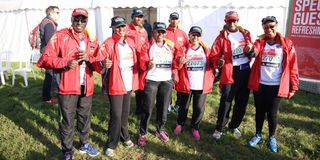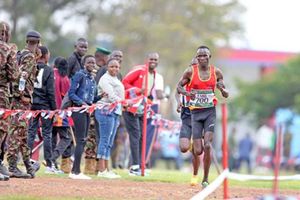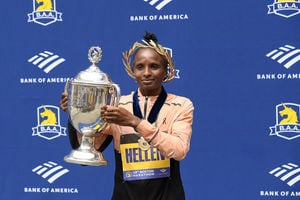
Kenya's Douglas Wakiihuri celebrates as he crosses the finish line of the marathon to win a gold medal at the 1990 Commonwealth Games in Auckland, New Zealand.
On the last day of the 1987 Rome World Championships in Athletics, former President Daniel arap Moi arrived at the Olympic Stadium unannounced and without the knowledge of the Kenyan delegation.
Standing amongst fans in the stands, Moi, towering above everybody else in a sea of white people was even more conspicuous when he raised his white ivory rungu immediately a young Kenyan, Douglas Wakiihuri arrived first in the stadium to the surprise of many to win Kenya’s first marathon gold medal at an international global championship.
Moi returned as he came with a few police officers and without saying a bye bye.
“I didn’t know Moi was in the crowd. Instead he left all of us talking,” recalls Wakiihuri who only came to know why the head of state was there and how lucky he was or why Moi must have felt equally pleased with his result.
Ordinarily, the host would have made proper arrangements in consultation with the Kenyan Embassy, Team Kenya and top World Athletics officials for the Head of State to be accorded the requisite protocols and meet with his subjects.
This was not the case.
Why, and what was doing in Rome?
Former Finnish Prime Minister Mauno Koivisto was responsible.
In 1987 Koivisto invited Moi for a state visit to Finland and laid down a grand banquet in the capital Helsinki with a Kenyan flavour by inviting two prominent Finland’s rally drivers who are household names in Kenya -- Hannu Mikkola and Juha Kankkunen.
Mikkola had won the Safari Ralli in 1972/87 and Kankkunen 1985, and Moi had been flagged off outside the KICC in diverse dates between 1972 and 1987 Safari rallies.
“It was a common practice in Finland to invite sports giants who had brought honour to the country,” writes Lee Njiru in his biography Presidents’ Pressman.
“During the evening banquet in honour of Moi, one of the guests was the famous Finnish rally driver Hannu Mikkola. He was also well-known in Kenya as he had participated in the Safari Rally,” writes Njiru.
“In his speech, President Koivestro poured praise on the rally drivers, saying they were the most efficient ambassadors of Finland across the world. He expressed his wish that Kenya could accord its sports giants the same honour.”
This caught Moi by surprise and the naked truth sank in because apart from presidents handing over or receiving the national flag of sports teams travelling to international events at State House, sports people are never invited to important state functions.
“I saw Mzee Moi fidgeting in embarrassment because no Kenyan administration so far had invited the country’s sports giant to state dinners,” Njiru continues.
Something needed to be done and an opportunity arose.
“After the dinner, the Kenyan delegation proceeded to Rome, Italy where they received information that Kenyans would be in action on the final day of the World Championships in Athletics, " continues Njiru.
“While in Rome we received information that a Kenyan based in Japan, Douglas Wakiihuri, will be participating in the championships, which were going on in that city,” Njiru’s book says in what was a private visit unlike in Finland.
“Moi expressed his wish to attend the games and cheer on the young Wakiihuri, a marathoner. We arranged with the Italian foreign minister who in turn provided a team of carabinieri for security escort.
“As Moi waved his ivory button to cheer Wakiihuri as he entered the stadium ahead of the park to win a gold medal, Italians were curious about this tall black man, waving a white stick.
“President Moi finally shook my hand after returning from Seoul Olympics in 1988 and later that year during Jamhuri celebrations when he conferred me with the Silver Star of Kenya,”Wakiihuri says at Karen where he had readily agreed to have an interview.
Wakiihuri was before then unknown in Kenya or the world of athletics since he had moved to Japan on an athletics scholarship in 1979 with the help of the late Sunichi Kobayashi, a Japanese who came to Kenya in the late 1970s.
Kobayashi fell in love with Kenya and developed a Japanese athletics connection with Wakiihuri’s uncle Wilson Waigwa.
“We were all surprised to hear later that President Moi had been in the stadium to receive me,” says Wakiihuri who went on to become one of the best marathon runners of his generation with a good track record in open road races and championships.
Wakiihuri finally had the honour of meeting President Moi at State House one year later -- as a 1988 Seoul Olympics silver medallist.
Wakiihuri, who went on to set a clean enviable record in the marathon by winning the 1990 Auckland Commonwealth Games and a silver in 1992 Barcelona Olympics, plus being the 1989 London Marathon and 1990 New York Marathon champion, always wore a white glove on his right hand.

Douglas Wakiihuri competes in the 1995 Athens IAAF Marathon World Cup. He won the gold medal.
Wakiihuri became the second highest commercially endorsed sportsman in Kenya after rally star Patrick Njiru in 1990 when DT Dobie launched the Nissan Sahara. Wakiihuri appeared as a driver powering the car towards the top of Mount Kenya.
He also opened doors for Kenyans, especially marathon runners to train and live in Japan, notably Samuel Wanjiru (2008 Beijing Olympics marathon gold) and Eric Wainaina (bronze and silver in 1996 and 2000 Olympic Games).
“Athletes hold Kenya dearly in their hearts. We have represented our people, decorated the image of Kenya with our lives and we can prove with the medals we wear and carry the weight of all the battles we have fought for Kenya,” says Wakiihuri.
He is a wise guy too and never shies away from fighting for the rights of athletes.
“Decorate us when we are still living but not when we are lifeless when the welfare is least needed,” maintains Wakiihuri who thanks the Nairobi County Government for renaming the slip road between Langata Road and Mombasa Highway outside Nyayo National Stadium in his honour.
Wakiihuri later became a musician, music producer and events organiser of the Sotokoto Half Marathon with funding from his Japanese friends.
He also coached former First Lady Margaret Kenyatta when she got involved in the Beyond Zero First Lady Half Marathon to raise funds for mobile maternity clinics for expectant mothers in the country.

Former First Lady Margaret Kenyatta (third right) and her team members (from left) Japheth Kariakim, physiotherapist, Nyokabi Muthama, Florence Awori, Douglas Wakiihuri, and Constance Gakonyo at the start of the Virgin Money London Marathon Charity Race at Greenwich Park, London in 2016.
He was conferred with the Kenya Golden Warrior Award by President Uhuru Kenyatta for his work.
The 62-year-old Wakiihuri received another recognition last Friday -- the Nyeri Icons Award for his contributions to sports and cultural development in Nyeri.
The former Olympiad has maintained his unique lifestyle. He runs daily, loves composing music, is a good graphic designer and assists young people with education and training equipment. He eats from his investments in athletics.
"In high school, I wasn't very social," he says. "I had friends. I didn't see them much. I spent most of my time doing my own things."
He loved the solitude and difficulty of running over Kenya's red earth, be it mud or dust. Yet Wakiihuri nursed a dream of emulating all the great Kenyans who lived and trained in Nyeri in the 1970s and 1980s.
Nyeri and by extension Central province fielded the best and strongest field in all national athletics championships spear-headed by such great athletes like the legendary Kipchoge Keino by virtue of the town being home to the Kenya Police Service Training College in Kiganjo.
Wakiihuri was born in Mombasa and schooled in Nairobi.
He grew up in many parts of the country as his mother, Lydia Wakiihuri, was a civil servant who worked in various Prisons offices.
In Nairobi he showed good promise in 1,500m to 5,000m, and always trained around Prisons grounds in Langata, an area he still resides in.
His uncle, Waigwa, also an athlete, who attended college in the US, encouraged Wakiihuri to maintain training and running.
Everything changed at age 16 in 1979 when he met Shunichi Kobayashi who told him about Kiyoshi Nakamura, coach of the great Japanese marathoner Toshihiko Seko. "I sensed there was another way of training in Japan," Wakiihuri says.
"It was not only physical, but mental and spiritual."
He expressed his ambitions in a letter to Nakamura, who invited him to attend a training camp in New Zealand in 1983. Wakiihuri passed the audition and, at 19, moved to Japan and quickly adopted by learning the Japanese culture and language.
"From that day," he says, "everything started working. I would go dining with Nakamura.
“He would talk about a lot of things. It was all a matter of whether you were listening. Are you patient enough to listen?" Wakiihuri once told Sports Illustrated.
They developed a strong bond but Nakamura died in 1985, so the 1987 World Championships in Rome was a dedication race. Nakamura taught Wakiihuri many things.
"You are not inside, so you will never understand. The only time people can understand is if they are in the circle and can experience it for themselves."






